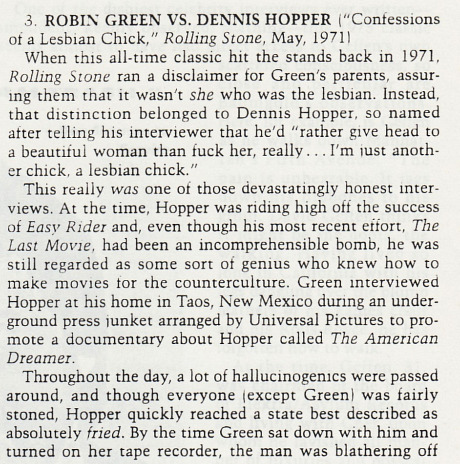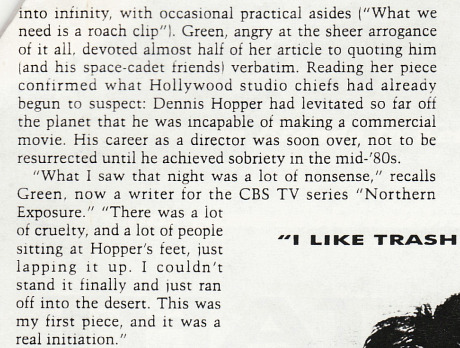L.M. Kit Carson and Lawrence Schiller‘s An American Dreamer, a 1971 doc about the late Dennis Hopper, was screened last night at the Walter Reade theatre by the Film Society of Lincoln Center. Speaking as a longtime pal of Carson’s and an admirer of Schilller’s, I regret being unable to think of anything remotely flattering to say. The vibe in the room was kindly and sympathetic, but what I heard and felt after the show was mainly polite astonishment. Why had Schiller and Carson decided to even show this thing?
I was stunned by the doc’s shapeless sloppiness, amused and repelled by its portrait of Hopper as a bearded, drug-fried horndog on the verge of destroying his directing career with the abomination that was The Last Movie, and appalled at the ugliness of the print (faded sepia-tones having replaced whatever color it had to begin with).
You might expect An American Dreamer to be a portrait of an allegedly gifted director (Hopper helmed Easy Rider two years before the doc was shot) at some kind of personal crossroads, his state of mind clearly affected (to put it mildly) by pot and hallucinogens. You’re thinking you’ll at least get to sample Hopper’s milieu and personality as he was finishing editing on The Last Movie, a film so allegedly incoherent that it ended his behind-the-camera career until he finally sobered up in the mid ’80s. And maybe get to “know” the guy on some level.
You get to know Hopper, all right. What a shameless, self-absorbed, cowboy-booted asshole. Watching An American Dreamer is enough to make you at least consider the Sean Hannity-Bill O’Reilly-Glenn Beck-Pat Buchanan view of the changes brought about by the counter-culture. And that’s a terrible thing to do to any viewer.
What The American Dreamer provides — and I mean all in and nothing else — is footage of Hopper swaggering, stoning and blah-blahing his way through several willing women at his hippie-commune home in Taos, New Mexico. He stammers on about this and that philosophical issue from time to time, but the bottom line is (a) he’s apparently dead-set on self-destructing and becoming the new Orson Welles (he talks at one point about his suspicion that The Last Movie probably won’t find much of an audience), and (b) there are girls galore — provided, I learned last night, by Schiller and Carson — and he’s going to enjoy as much fine soft flesh as he can get his mitts on.


All Schiller and Carson did was just shoot and shoot and shoot as Hopper swaggered around and sampled the wares. And it was awful, just awful to sit there last night and watch this 40-year-old grope-a-thon unfold so haphazardly. Jett, sitting next to me, was chuckling and groaning. “This was the ’60s?,” was his basic reaction. Several serious people were there last night — director James Toback, Entertainment Weekly critic Owen Gleiberman, etc. — and I was sharing with all of them the same two thoughts: “Why?” and “What the fuck?”
With so much blather in the air, the viewer is soon dying for reality checks of any kind. Schiller and Carson, enamored of Hopper and/or flattered by his largesse (and most likely enjoying the harem atmosphere themselves), provide absolutely nothing along these lines. They never engage Hopper in discussions of his acting career. They never talk to critics or film executives of the time to get a sense of perspective. And they ignore a seminal Rolling Stone article that was written about Hopper’s ongoing Taos orgy — a piece by Robin Green called “Confessions of a Lesbian Chick.”
If Green’s disapproving perspective had been somehow included in the doc (by way of a hindsight re-edit, say) it might have been, perhaps, half-tolerable, but without it it was all punishment. I summarized Green’s piece in a 1991 Movieline article I wrote called “Ten Interviews That Shook Hollywood.”
I was truly mystified by Schiller and Carson’s decision to show a raggedy “pink” print despite Schiller’s admission that a decent-looking print exists. The good print isn’t being shown, he said, in order to protect it from wear and tear, but why not digitally scan it and show that? Cost, said Schiller. He mentioned a figure of $31 thousand. I called restoration guru Robert Harris this morning and asked about this figure. “First of all you’re going in the wrong direction,” he said. “You don’t want to scan a print but the negative. Where’s the negative?” Nobody mentioned that, I said, but if you had the negative and it was in decent shape, what would it cost to scan it and create a digital master? “2500 to $3000,” he said.
